Text
From Namban to Cool Japan
---------This text was first presented at the “Conferências da Primavera 2024” at Centro Científico e Cultural de Macau------------------------------
You can find the Portuguese version here.
The Portuguese arrived in Japan in 1543
I believe that surprise would be the emotion that would characterize this first contacts. The Japanese would meet, for the first-time people that talked and looked completely different from them. They would call these people Namban– Southern barbarians - a word first used by the Chinese that with time would identify the Europeans that arrived in the Japanese territory.
We could say that the fortunes that the Nau - ship- brought, not only in merchandize but also its people, would end up molding the first impressions of the Japanese: these barbarians where people that had a large variety of treasures and riches they never dreamed obtaining. Soon, the presence of the Jesuits would end up being a kind of spectacle for the people that lived far away from the ports, to which the processions would call the most curious eyes.

Not only where the Portuguese the ones that adapted to the ways of the Japanese, but the opposite would also occur, just not in a such a visible way, because all these contacts were happening in Japanese territory.
With the Nau arriving at the ports year after year, some people started to understand the Portuguese. Yoshimoto Okamoto tell us that after this date, the people started to imitate the Portuguese, adapting elements form they diet, clothing and furnishing into their own lives, and incorporating in their ways of talking some common Portuguese words. Not only the new Christians started to learn Portuguese, but also the common folk that little by little would integrate some words into their everyday life demonstrating that they knew about this new change of times [1]. The clothes started to take some European inspiration such as the adoption of collars and buttons, but it was the sacred objects like rosaries and crucifixes that started to have, not only a faint symbology but also one that showed the knowledge of this new culture that would turn out to be more like a fashion for the Japanese. “They wear rosaries of driftwood on their breasts, hang crucifix from the shoulder or waist, and sometimes even hold a handkerchief. Some, who are specially kindly disposed, have memorized the Our Father and the Hail Mary, and recite them as they walk of the streets.” [2]
It was precisely this last sentence that inspired me to present this theme. The simple fact that the common Japanese was singing the Our Father or Hail Mary on the streets reminded me of how a lot of Portuguese people today sing “Blue Bird”, the third opening of Naruto Shippuden on the streets like it’s a mantra.
Not having the time to present and explore the Japonism of the 19th century and the exchanges that happened in Europe and Japan after the end of the Sakoku, I do have to pass right to the present. I do believe it safe to say that the actual image of Japan is not of a military potence. Maybe samurai from far away times. But, with a lot of probability, an utopia full of characters with big sparkly eyes.
Being that I’m also part of this world of Japanese pop culture fans, it made sense to use an ethnological approach to the data collection. Mark Duffett tells us: “Critics might argue that ethnography leaves to much room for subjective interpretation and research bias. (…) The researcher acts as a kind of cultural translator who is privileged to explain the alien ways of a different cultural world because he or she has entered it as a surrogate for “normal” readers” [3] . Just like the best way to understand the exchanges that happened in the Namban century is to look at the populations that inhabited the places were the Kurofune would dock, the best ways to understand the ways in which the Japanese culture interacts with the Portuguese is to look at those that deal with her in their day-to-day life. And being that this culture exchanges happen mainly on the internet, it was here that the data was collected.
On February 29th it was open a questionary on Google Forms, that was shared on the authors social media, as well as on Reddit at the forum r/animeportugal, being closed on March 09th with a total of 55 answers.

When asked “What was your first introduction to the Japanese culture” 96,4% answered anime; only 1 person identified that it was in history classes and 1 thanks to the Orient Express Section on Fantasporto (International cinema festival in Porto). These results can be easily explained: in Portugal the 1st wave of Japanese animations screened on national television happens in the 70s. I do believe in the familiarity with series like “Heidi” (Heidi: Girl of the Alps), animation directed by Isaso Takahata, one of the future founders of Studio Ghibli, that was screened in the Portuguese televisions on 1976, or “Abelha Maia” (Maya, the honey bee), a collaborative animation between Japan and Germany screened in 1978 both at RTP. The 2nd wave happens in the 90s with the screening of Sailor Moon by Naoko Takeuchi and Dragon Ball by Akira Toriyama.

This wave of successful importations happened in part thanks to “Dynamic Portugal” the group responsible for the importation of international media, that was behind SIC Radical in the 2000s [4]. With the focus shifting from the televisions to the internet we are able to identify a 3rd wave happening recently in the years of the Covid-19 pandemic. Taking “The boy and the Heron” movie that recently won the Oscar for best animation as an example, it was able to acquire 200 thousand euros in revenue, becoming the 2nd most watched movie in Portugal, losing only to Jujustsu Kaisen 0, prequel to the popular animation series Jujutsu Kaisen by Gege Akutami.
When asked “What makes you like anime/manga?” I collected answers that were divided in 3 categories. The 1st one, does include the answers of people that say that started watching anime thanks to channels that specialize in the transmission of these animations, such as “Canal Panda”, being that there were 5 answers that specified “Dragon Ball”. In the 2nd it was the people that started thanks to recommendations of family or friends. The 3rd, and the biggest one, was from the people that got the interest thanks to the quality of the animation and stories. Citing directedly one of the answers “The stories are usually very different from the norm and the more adult and older animation style of the anime pleases me visually. Not to mentions that there are few animations with an adult story that are not comedies.”

In a funny way, when questioned “What do you like the most about the Japanese culture?”, most people answered the food, being that in 2nd place came the culture, and only in 3rd came the anime. In the answers that said culture, we start to see the Soft Power taking place, being that we can observe some Japanese stereotypes. Just as William Tsutsui tell us: “From pop music to consumer electronics, architecture to fashion, and animation to cuisine, Japan looks more like a cultural superpower today than it did in the 1980s, when it was an economic one” [5].
The confirmation of these stereotypes happens in the answers to the next question “What is the image that you have from Japan?”. Taking as an example the answer “It is a utopia of different cultures, foods and styles”, there were a lot of answers that were variations of this idea that Japan, more than a country, is precisely an ideal and perfect society. From being a tranquil country, innovative, that values the nature, organized, with a huge education, comfort to a big culture and history. Nonetheless the 2nd block of answers starts to denouncer a bigger knowledge of the reality with ambivalent answers. “Since I was born and raised in the European world, I am aware that it’s a very different country from ours, both culturally, politically and economically. However, and very interestingly, it itself is quite different from the other geopolitical blocs in Asia. Despite all the color and animation that anime and manga can bring to the image that the Western world (and even within Asia) has of Japan, I believe that on a social level it is very different. Take, for example, the case of communication, which are often exacerbated and even ridiculed to a certain extent in popular culture, and in real life are a requirement in the manual of good practices and manners. Or see the case of alternative attire; In the anime and manga we see very various characters, however young people often complain that Japan is not so open to a more alternative lifestyle, also saying that Japan is an essentially traditionalist country.” Even if most of the times, the answers learned to a positive side, we find nonetheless a bigger attention to the reality of the country with a look that is not filtered by the popular culture that is consumed.

When questioned “Are you part of any fandom?”, 52,7% answered in a negative way being that only 47,3% answered in a positive one. To those that answered that they were part of a fandom it was asked to complete answering from which series or games. This raises questions, that are not new, of what truly means being a fan. In the Infopedia dictionary we are informed that “Fan” is “a person that does have a big admiration/interest to something or someone”, adding that it derives from the shortening of the english word “fanatic”. This could demonstrate that people are still reluctant to call themselves a fan and assume themselves as such with the fear of being judged in a pejorative sense as fanatics or childish.

When askes “Did you know that the Portuguese were one of the firsts Europeans to have contacts with the Japanese?”, a surprising 81,8% answered that yes, being that only 18.2% did not know. From this 81.8% the majority complemented that they learned in the history classes during the various years of education, while only a small part discovered from themselves or via social media.

When asked “Do you consider that the Japanese culture does have an influence on your everyday life?” 58,2% answered yes, 12,7% that no, and 29,1% answered that maybe. This shows that the people are somewhat conscious that the Japanese popular culture integrated itself in their everyday life and how this affects them. This crescent global popularity of anime made a new global generation that is familiarized with this new cultural hybridism and that prefers these denationalized fantasies that the Japanese animation proportion [6] . This is clearly visible in the ways of expression of various people, but mostly the young adults, in the ways of talking, gestures, dress, gastronomical preferences and entertainment. It is possible to see a growing number of events dedicated to the Japanese culture from big conventions such as Iberanime to small cosplay meets, or the popularity of stores like Conbini or Hypertoys that caters products and experiences for this kind of likes. Just like João de Deus Ramos said: “The globalization that we talk about so much today actually corresponds to a reality, but it is not new. New will perhaps be only the degree.” [7]
[1] Okamoto. 1972. Pag. 68
[2] IDEM
[3] Okamoto.1972. Pag. 77
[4] Duffett. 2013. Pag. 421
[5] Barros. 2016. Pag. 33
[6]Tsutsui. 2010. Pag. 59
[7] Napier. 2005. Pag. 26
[8] Ramos. 2012. Pag 161
ALFAIATE, Rita. 2023 – “O influxo do Hibridismo Cultural na Banda Desenhada Portuguesa a partir dos novos autores” Tese de Douturamento. Universidade de Lisboa.
BAIN, Marc. 2020 – “How Japan’s global image morphed from miltary emprie to eccentric pop-culture superpower”.Quartz, 21 de Maio, 2020. https://qz.com/1806376/japans-image-has-changed-from-fierce-to-lovable-over-the-decades
BARROS, Carlos. 2016. – “A influência da cultura otaku na sociedade ocidental”. In E-revista de Estudos interculturais do CEI-ISCAP Nº4. Porto.
DUFFETT, Mark. 2013. – Understanding fandom: na introduction to the study of Media Fan Culture. Nova Iorque. Bloosbury Piblishing Plc.
FLORES, Jorge. 2022 – “Quando éramos exóticos”. In Histórias de Um Império: Coleção Távora Sequeira Pinto. Lisboa:Fundação Oriente.
KELTS, Roland. 2008. – Japanese Pop Culture: Its Problems - & Its enormous portential. In Japan Spotlight. Japan Economic Foundation.
MEIRELES, Selma Martins. 2003. – “O Ocidente Redescobre o Japão: O Boom de Mangás e Anime”. IN Revista de Estudos Orientas n.4. Pag. 203-211
MOCKETT, Marie Mutsuki. 2016. – “Our Fairy Tales Ourselves: Storytelling from East to West”. Literary Hub, 27 Janeiro, 2016. https://lithub.com/our-fairy-tales-ourselves-storytelling-from-east-to-west/
NAPIER, Susan J. 2005 – Anime from Akira to Howl’s Moving Castle: experiencing contemporary Japanese animation. Nova Iorque: Palgrave Macmillan.
OKAMOTO, Yoshitomo. 1972. – The Namban Art of Japan. Nova Iorque: Jonh Weatgerhill, Inc.
RAMOS, João de Deus. 2012 – Portugal e a Ásia Oriental. Lisboa:Fundação Oriente.
RO, Christine. 2019 – “Did manga shape how the world sees Japan?” BBC Culture, 12 Junho, 2019. https://www.bbc.com/culture/article/20190610-did-manga-shape-how-the-world-sees-japan
TSUTSUI, William. 2010. – Japanese Popular Culture and Globalization. Association for Asian Studies. Columbia:Columbia University Press.
0 notes
Text
New years planning
So the new year just begun, and so it's time to start planning (at least I do or else my OCD kill me) For those that do not know I've recently lost my job. I did not like it, but I was used to it and the money was welcome. So December was a month were I tried to adapt to this new routine. It was an hard month but now with this 2024 planning I'm holding myself acontable. (Meaning writing it here means that I have to do it.)
Since my huge plans only happen at the last semester of the year (let's not jinx it) I really need to start organizing my life for the time being. We all know that life is unpredictable but let's live a day at the time. Carpe Diem am I right?
At this moment I'm trying to find ways of financially support my researches. Meaning official ways but also the internet ways. I will try to promote my page for all of those that love history with a touch of weeb. Maybe I can do some small topics recomended by you? It sounds fun!
The Hell's Paradise project is already in motion! I can start to do some sneak peeks and maybe start posting the moment I take pictures of my Sagiri cosplay, but boy let me tell you this one is harder than my Demon Slayer one.
I would also love to start posting random things that I research too! Always in the Japan theme but I sometimes decide to read books non related to the main topic like Orientalism in Portugal ou the Japanese mythology, so maybe I can start info dumping on the internet.
One thing that I'm determined to do, is reconnect with my artist side. You know, sometimes I simply forget that I can draw, and when things don't go the way I plan I just get discouraged. But I most stay positive and try all over again. (Maybe it's time for a Blue Period rewatch)
But anyway, let's see what 2024 brings to us
All the love, and happy new year 💫
0 notes
Text
New post on my Ko-fi!!
1 note
·
View note
Text
Senbonzakura - Introduction
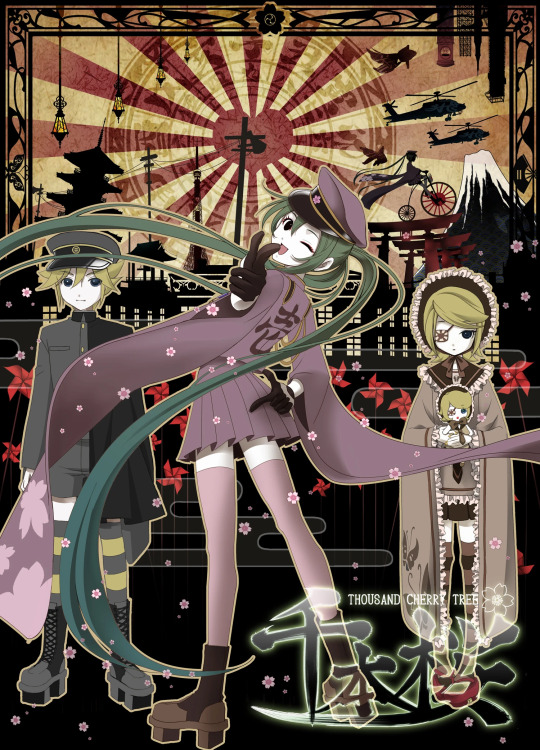
There are certain places on the internet where the song Senbonzakura originally by Hatsune Miku is being cancelled because some people say that it is Japanese imperialism propaganda. Their biggest point is the fact that in Korea this song is not in the official games. Tanjiro’s earings in Demon Slayer were also censured and I don’t see anyone cancelling the anime, and it does actually take place doing the imperial times! Now listen, the wound is still pretty fresh, and the fact that Japan does not acknowledge his war crimes only makes it worse, and so Korea decides to simply censor all that is related to the Japanese imperial times in popular media. And in fact, Senbonzakura talks about that, but not to glorify it. Just a look at the lyrics and you will find that it is a critique that was made to remind us all of times that Japan would prefer to make everyone forget.
If there is one thing that the Oppenheimer movie got extremely right was that in fact Japan would not surrender if it was not bombarded. I know it's hard to ear, but it is the naked truth. In fact, there was almost a 3rd bombing, in Tokyo, but after much discussion the emperor decided to finally surrender. Yes, discussion, because in the minds of some ministers and officers the thought of surrender was unthinkable. Actually, there is a famous photo of a Japanese soldier that committed suicide taking a grenade with him into the sea because he prefer that to being captured and surrender. For lord, they created the kamikazes. The idea of annihilating the country while fighting was better than surviving but being defeated. But the Emperor had the final word and he had to choose between this supposed honourable fight or protecting his people. Being the last emperor of a dead country or continuing the legacy.
But let us start from the beginning.
#hatsune miku#hatsune miku senbonzakura#senbonzakura#japanese history#japan research#research#anime history#vocaloid
0 notes
Text
The Red Oni & The Blue Oni
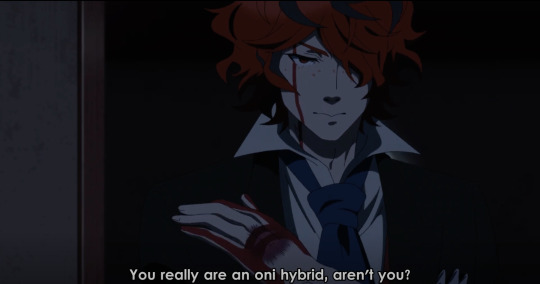
The moment I saw the confrontation of Jack and Tsugaru I realised that they were a pretty obvious omen to the Red Oni and Blue Oni. What is this Red Oni and Blue Oni? Well, a little classic story in the Japanese imagination.

Hamada Hirosuke wrote “Naita Akaoni - The Red Oni who Cried" that is a story that talks about a Red Oni that wanted to be friends with the humans, and so, his Oni friend, the Blue Oni, attacks the humans so that the Red Oni could be seen saving them. "Hamada's Oni are righteous and pure-hearted: the red Oni is friendly and prepares tea and home-made cakes for the humans, while his counterpart, the Blue Oni, espouses qualities of self-sacrifice by putting the needs of others ahead of his own. The blue Oni is considerate enough to leave the are so as to prevent his friend's cover from being blown. Such conduct among human was increasing rarity at the time the story was written." (Reider, 2003) This story ended up starting a trope trend, as we can call it, the Japanese media where we see two individuals either enemies or allies that represent the two sides of the spectrum of the personalities. And when we start to take notice of this, we are going to notice it everywhere.
“This trope is about two individuals (or occasionally, factions or civilizations) that are significantly linked together somehow (such as through a rivalry, friendship, being siblings, co-workers, competitors, etc.) that have differing personalities and, with it, often different approaches to the world in general, especially whatever they might be competing in/for/over” (TVtropes) The Red Oni normally does have a more extroverted personality, associated with passion, wildness and defiance, most of the times being the “idiot hero” that does not care about criticism about them. The Blue Oni on the other hand tends to be the introverted one, associated with serenity, control, and authority, mostly being respected in a way that can be confused with intimidate.
Now, have you realized something? Yes, in the case of two Onis the personalities are swapped. “While many expressions of this trope play it straight, it is also not uncommon for the Blue Oni and Red Oni to mix traits” (TVtropes) While Tsuguri, having the colour blue is the dumb one, Jack is the intimidating one. Also, we can see the contract in their fighting styles. “In a show where it's relevant, differences in fighting style may be something like Technician Versus Performer.” (TVtropes) (Which is extremely funny coming from the fact that Tsugaru is literally a performer)

It’s funny to think that the author decided to go with such a clear reference, and still make it so different. It also can make you think what Tsuguru does have store to surprise us even more. We need to continue watching the anime, or read the books to a better analyses of the characters, but at least we have a surface idea of their psych.
REIDER, Noriko T. 2003 - Transformation of the Oni: From the frightening and symbolical to the cute and sexy. Asian Folklore Studies, Volume 62, 133-157. Ohio: Miami University. <https://www.jstor.org/stable/1179083>;
TVTROPES. N.d – Red Oni, Blue Oni. Accessed August 28, 2023 <https://tvtropes.org/pmwiki/pmwiki.php/Main/RedOniBlueOni>
#undead girl murder farce#undead murder farce#japanese history#anime history#oni history#oni#tsugaru shinuchi#jack the ripper
23 notes
·
View notes
Text
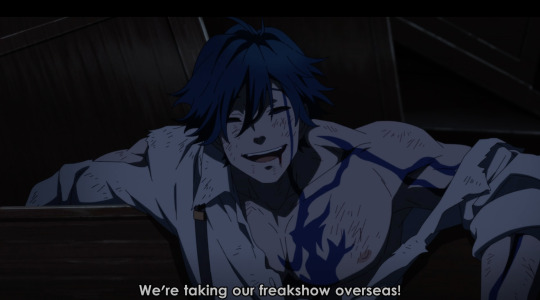
Hey Siri play "Calling all the monsters by China Anne Mcclain"
32 notes
·
View notes
Text
The Immortal & The Oni 🐉

As I already dived in the waters of the Oni history, I believed that I would not talk about it in the near future, yet here we are. As the show Undead Murder Farce slowly becomes a new obsession, an while I’m gathering all the materials necessary for my future project this seemed as a great in between project. (Cause apparently, I like to put way too much stuff into my hands)
The show presents us with an Oni, that was part of the Meiji purged against all the Yokai, and that now works in a “theater” [That is more like a freak show, common in all parts of the world at the time]. We soon found out that Tsugaru Shinuchi is in reality a half-Oni. We could think that he came to be born as a son of the intercourse of an Oni and a human, but it was someone that was able to transform him into an Oni.

And this important information is given to us by the head of what remains of the Immortal Aya Rindo. And we also find out that Aya is an immortal, thanks to the shoot on the dark were Tsugaru asks if she is an immortal.

You can read my other blog post for a more in depth explanation about the Oni, and how that change throughout the centuries, since I’m going to keep it short here.
Oni are part of the Yokai culture that always played an important part in Japanese lives. They are believed to be born from the fear of natural disasters and would then evolve into being associated with almost everything that a human could have considered as bad. Aya also says that the world Oni also means “servant of evil” (Cue the Vocaloid Song). That is an omen to one of the biggest legends about Onis, and that they were born after Izanagi’s being offended after her male counterpart saw her rooting in hell. In the Edo period we start to see a more comical version of this monsters that for so long hunted the Japanese minds. In the Shuten Doji we can see an Oni that regrets its killings, becomes obsessed with sake, and loses itself in woman. (Hello there Tsugaru ancestor) In these stories we also find Onis that are humans that slowly transform into Oni’s after slowing falling into the temptation of their stronger feelings and committing crimes.
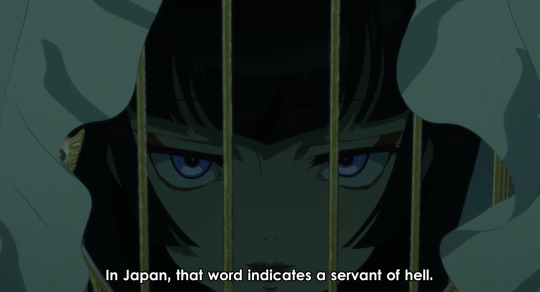
Now, Onis or Oni inspired characters are a common appearance in many media, but I think the idea of Immortal was a little different. Maybe if you also read Chinese novels like Danmei you can be somewhat familiarized with similar concepts, but the whole idea can still be a little confusing. So, what exactly is an Immortal?
The concept of the Immortal comes from Daoism where these beings have obtained an extended longevity after training for the control of their spirit and body. They are believed to be able to live from pure qi or dao – the foundations of the world. Living detached from the society, they obtained magical powers as an extension of the practice of transforming their qi into primordial qi. “Immortality implies the overcoming of the natural tendencies of the body and its transformation into a different kind of energetic constellation” (Kohn. 2009)
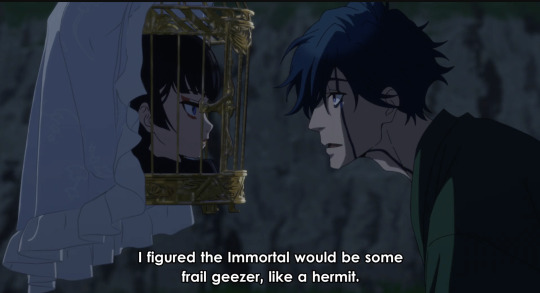
There are two types of immortals: the ones that were born from Dao, representing the core of heavens and scriptures, or the ones that were humans and transformed into immortals either thanks to elixirs or various practices that accessed the Dao. (Kohn, 2009) “Immortals are physical beings (…) But while the gods of the mainstream pantheon consists of high yang energy and the dead of high yin, immortals are beyond either, having bodies of ultimate yang that makes up the base of all others forms of qi” (Kohn, 2009)
It is funny to think about the reasoning behind why an Oni is the only creature that can kill an Immortal. The theory is mostly based on the five elements where there is not an element that is stronger than the other since there is always an element that can subdue the other. The same happen here, since Oni are the ones connected with hell (ying), they are the only ones able to kill an immortal that is mostly yang energy.

“Oni are the Yokai with the most negative associations” (Reiner, 2010) while an immortal is mostly associated with good things. They are in opposing sides of the spectrum and so they complement each other.
Bibliography:
KOHN, Livia. 2009 - Introducing Daoism. JBE Online books [Ebook];
REIDER, Noriko T. 2010 - Japanese Lore: Oni from Ancient time to present. Utah: Utah State University Press. [Ebook];
REIDER, Noriko T. 2003 - Transformation of the Oni: From the frightening and simbolical to the cute and sexy. Asian Folklore Studies, Volume 62, 133-157. Ohio: Miami University.
#undead girl murder farce#undead muder farce#oni#immortal#tsugaru shinuchi#aya rindo#history#japanese history#history research
7 notes
·
View notes
Text
Namban Bunka ⚜️
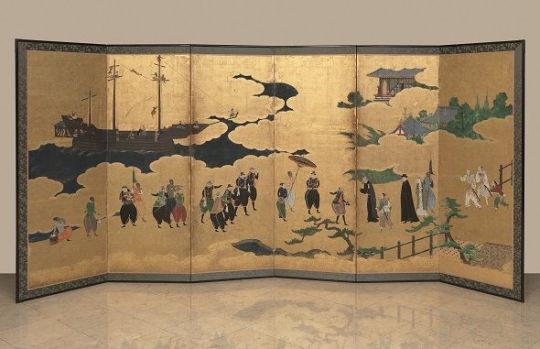
We talked about how the Portuguese were the ones introducing the guns in Japan. Now let’s do a deep dive in one of my favourite topics: the namban bunka.
As I have said many times, the Portuguese arrived in Tanegashima, a small island at the south of Kyushu in 1543. The reason of their arrival was a mix of pure luck, curiosity and the “discoveries of the crown”. Now, if you don’t know, having started in the 15th century, Portugal was “discovering the world”. Yes, with a lot of quotation marks because most of the time the places that they were “discovering” had already native societies, but in the point of view of the westerns, it was a discovery of new cultures and the world.
On the other hand, China, around 1500 had abolished the maritime explorations because they were in need of more man in the northern borders to fight against the Mongol invasions. Now, just because the government decided to abolish the commerce, they did not think about the fact that the commerce was still made in silver, and so they needed Japanese silver. And that’s where the pirates came into action. Silver for Silk. And yet this was a dangerous job that the government frowned upon. And so, after the conquest of Goa the Portuguese decided to go on to China and ended up becoming the 3rd country needed to smooth the commerce between these two empires. So, Macau would be “given” to the Portuguese, and they would arrive in Nagasaki in Chinese junks. And they would create one of the most profitable routes of the Portuguese empire.
In the Portuguese naus also went the Jesuit, and they realised soon that this country was not like any of the others. If they tried the old missionary ways of looking poor, people would cast them away, but if they when to the daimyos as nobleman, showing of the knowledge and goods they brought from the other side of the world, they would be listened. And so, it became important to gain the trust of daimyos, for security but also because if a daimyo would be converted to Christianity, then, thanks to the fidelity bonds, the inhabitants of his territory would also be converted.
Talking about Christianity, it was the missionaries that first created a Japanese dictionary. After Francis Xavier trusted the translation of the bible to a young Japanese merchant, and him failing badly, the Jesuits decided that the best way was learning the Japanese language so they could preach, but also enter debates with the Buddhist sects.
But was we know the power was fragile in this time, as so the luck of these Europeans was the same. Since Oda Nobunaga was not a huge fan of all the Buddhist sects in the territory and their influence, he took advantage of this natural rivalry. On the other hand, Toyotomi Hideyoshi thought of the Jesuits a threat, mostly because of the idea of “all being equal in the eyes of God”, and that the religious system would not bow to the political system. Still, he let Christianity be in it’s status quo. But, with the rise of power of Tokugawa Ieyasu, then rises the hatred on Christianity. Telling the tale that Christianity was destroying all their native culture [even if he also took pleasure in destroying Buddhist temples, but since he was Japanese its fine] and that thanks to their ideas Daimyos were now responding to God and not their ruler, he took on his hands the start of a persecution. And so, no one else could be converted to Christianity, and so it would suffer a suffocating dead, even if some still defied the government and still practiced the religion in underground tunnels. The Jesuits would be expelled from Japan in 1614, but since Christianity and commerce were hand in hand, some still tried they luck, and what would end up happening is that the Portuguese were also expelled from the country in 1639, and the Dutch limited to Deshima.

But what exactly makes the namban bunka?
Well, when these Europeans arrived, they were a novelty. Japanese people had never saw people with different characteristics from them. In the max, they have contacted with Indian, but never white or black people. So, they quickly putted them into their arts. Starting with the most famous ones, the namban screens. We are going to see this amazing procession of the Europeans coming out of their boats. There are actually various variations on the same theme, but one thing is for sure, the Japanese artist make sure that the viewer could differentiate the natives from this “barbarians”. And the way they did it was by amplifying the most prominent characteristics like the eyes, chin, nose and obviously the clothing. One characteristic that makes these screens so special is also the use of golden foil in the scenery, in particular, the clouds that help us distinguish the various parts of the action. But, with Jesuits creating schools in Japanese territory, they also started to teach the western kind of painting – a more realistic style – to young Japanese students. But unfortunately, they manly used these new techniques to paint copies of European art, and not some original work.
We can also trace namban inspirations in the furniture. Not only in terms of style – meaning the artisan would go on to replicate indo-portuguese furniture styles – but also in terms of decoration – they would decorate them with namban themes – literally painted them on the furniture- but also make special ones decorated in the style liked by the Europeans, for the commerce purpose.
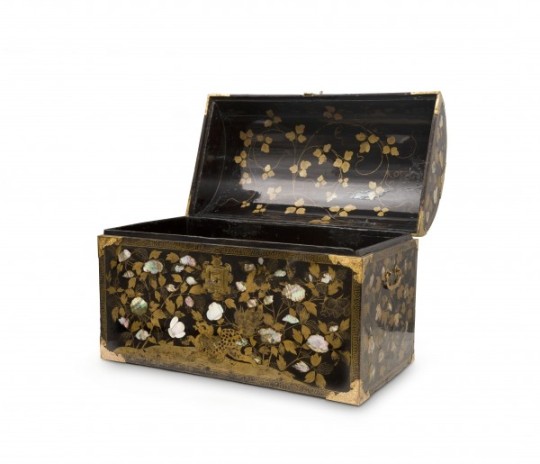
In terms of dressing, the “weird” ways that the western dressed would go on to be a niche fashion in the higher classes. They would integrate new fabrics, as well as western symbology, mainly Christianity symbols like crosses, into their normal dresses.
One of the most famous Portuguese introductions would be the guns. But still, they would decorate these guns with representations of the namban. Not only on guns but also in other things like the helmets, stirrups, and metal shoes.
In terms of architecture that would be a more difficult thing. Westerns were used to their buildings being made of stone. Japanese used to them being made from wood. Still, the westerns adapted and started to mix their ways asking local artisans for the best ways to introduce western elements into the architecture. But most of the times, they would simply buy older Buddhist building to transform into churches and their living quarters.
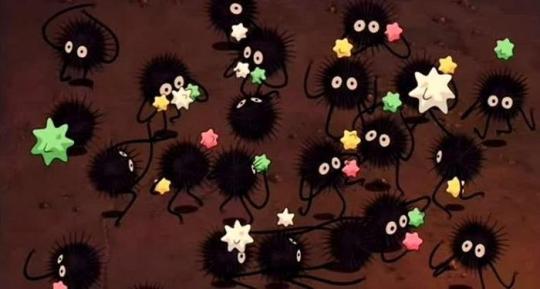
The remains of this contact of almost a century are still visible in Japan today, we simply just think those this a Japanese. Starting with the talking language, words like ボタン Butan, パンPan, カップKoppu, シャボンShabon, たばこTabako, カルタKaruta were imported from the Portuguese Botão, Pão, Copo, Sabão, Tabaco e Carta. In the gastronomical sense we can also finds a lot of Portuguese influences. The Portuguese introduced fruits like figs, pears and grapes and the eating of chicken and rabbit. Then we can still find Aji no Namban-Zuke – mackerel marinated in a sour-sweet sauce; Namban Chicken – fried chicken; Keiran Somen – sweet egg “noodles” counterpart of the Portuguese Fios de Ovos; Kasutela – a small cake taken from the Portuguese Pão de Ló; Tempura – fried veggies or shrimp that the missionaries created since they could not eat meat during the Lent; And our favourite Konpeito – that comes from confeito, is a small sugar candy that was introduced since sugar was not common in Japan. These small things are the echoes of a past long gone but that remained in the culture as a way to not be forgotten.
1 note
·
View note
Text
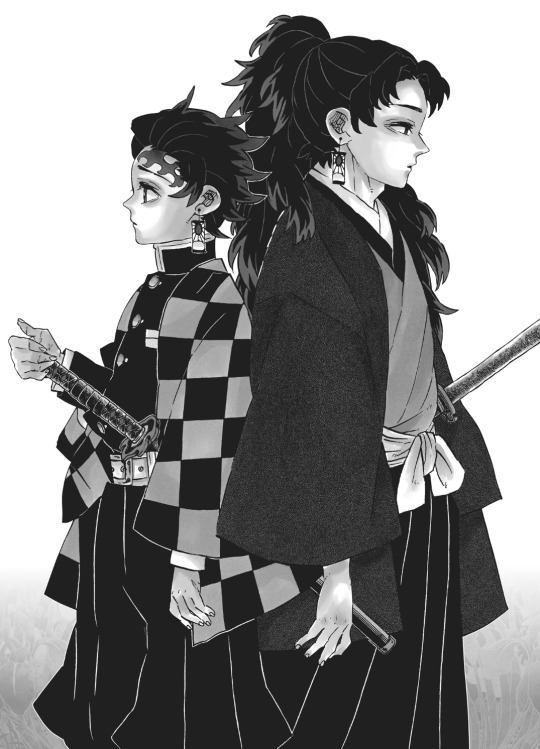
And it comes to and end!
My small Demon Slayer project came to and end! I does not mean that I will stop publishing about the anime just that all the research that I have made specifically for it ended and I'm now working on other topics.
This project was truly a passion project and made realise how much I love merging this "two sides os the same coin".
I hope you guys loved this as much as I did and that will continue to support me on this journey about learned more about Japanese history, culture and art.
Keep your eyes open for my other projects,
with love,
Ella
#demon slayer#demon slayer from history to fantasy#demonslayerfromhistorytofantasy#history#japanese history#history research#kimetsu no yaiba#demon slayer history#research
1 note
·
View note
Text

Lil something on my Ko.fi
#demon slayer#demon slayer from history to fantasy#demonslayerfromhistorytofantasy#history#japanese history#history research#kimetsu no yaiba#demon slayer history#research
0 notes
Text
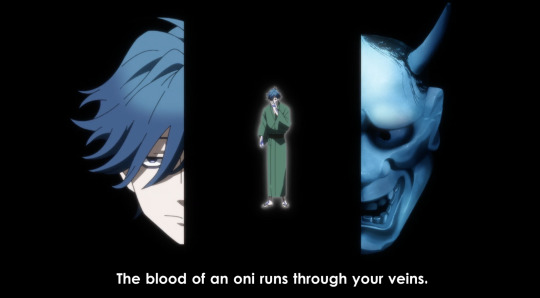
Get ready to my in between research topics
10 notes
·
View notes
Text
The sword, heart of the samurai, or so you thought 🤺
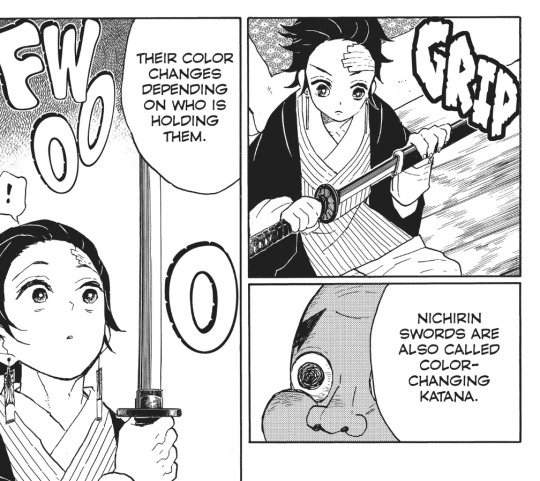
There were three sword hunts during the course of Japanese history. The first one was the Hideyoshi sword hunt during 1580, where it was ordered that only the samurai class could have swords. The second one was the 1876’s Meiji government order to abolish the wearing of swords, with the consequent ending of the samurai class. And third one was in the post WW2 where the Allied Occupation banished everything that could be a weapon and the katana stopped being a weapon to start being a work of art. While it could be argued that they are technically not true sword hunts, the reality is that they shaped the way the Japanese society behaved around said swords.
Swords were a symbol of status, a symbol of the warrior. Or at least it looked like it.
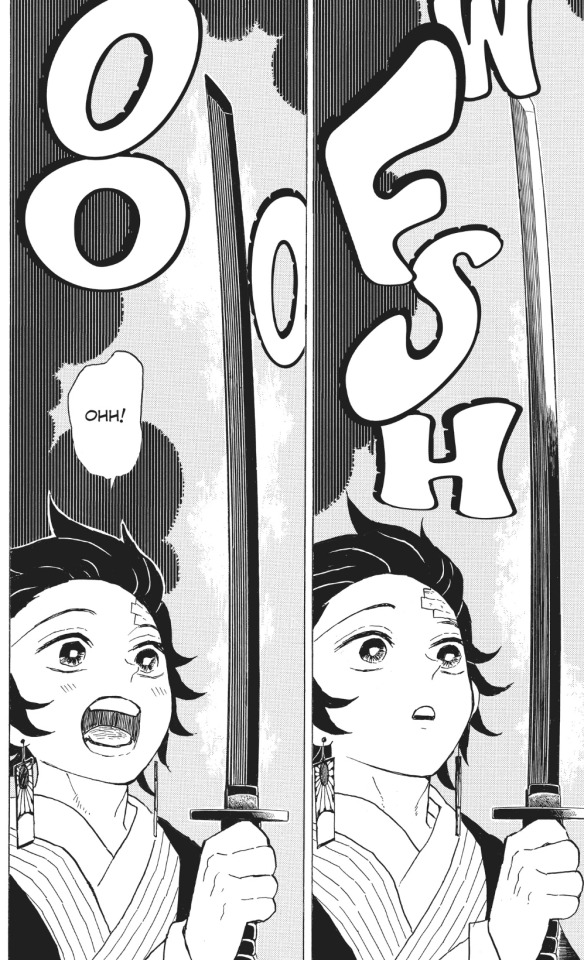
During a long time, war as made by bow and arrow. Then, various types of swords started to appear: the katana (sword), tachi (long sword), hoko or naginata (halberd), yari (lance). But guns were introduced in the 16th century by the Portuguese in Tanegashima, even tho gun powder was already knowned thanks to the Chinese. (If you watched Princess Mononoke, you can see that the guns they used are inspired by Chinese guns and the “more powerful ones” are inspired by the western ones) There is this myth that the oh so mighty samurai would never touch on a gun. Yah sure, they loved them, or at least during the times they were a novelty.
One of Nobunaga's biggest victories was in Nagashino when he used an army with musketeers, and mixed western military techniques with Japanese ones. If they could fight from afar, they would. For instance, the Boshin war was mainly fought by gun. The only fully modern sword fight was the Jipuren rebellion and that happened because they were precisely fighting against the ban of the swords. Also, guns could be expensive to maintain, but it was even more expensive to train someone during years to yield a sword.
The fact that the sword alone was portrait as the soul of the samurai since ancient times has a lot to do with its myths and significance. For instance, one of the imperial artifacts is a sword, so it does have this air of authority. Also, the fact that you behead a person with a sword (the French are laughing with the guillotine) so it was the significance of the ending of a battle. The sword became the social status of the samurai, so when the sword hunts started to affect their status, they started to take it personally.
Japan swords had a symbolic value, fat greater than they had in Europe. It was not just the OG fighting weapon, it was a palpable form of honor, ence “the soul of the samurai”. It was the only embodiment of honor, and it was an obligatory part of one’s costume. You could not have a family name unless you had a sword. If one commoner made something that would make him go up in the social hierarchy, he would be guaranteed the myoji-taito - a ceremony where he would receive a sword and a surname.

Swords were also highly symbolic because of the way the samurai would handle it in battle. There were manuals that would explain the most beautiful and at the same time masterful way of using the swords. And managing a sword was seen as more elegant that managing a gun. Even in the gun teaching manuals it looked like in the remarks that the teachers were sorry because there was not truly a prettier way of handling it. Still even with guns, they always carried a sword. Men felt undress without their swords.
But sooner or later swords would become works of arts thanks to their masterful swordsmith. Major swords dubbed as works of art. Yes, swords are seen as major metallurgical works of art in a lot of part in the word but in Japan they would take this to the extreme. For instance, when Mitsuhide was sieged, he asked for a quick moment of truce so that his swords could be taken out of the castle to the enemy territory and be same, and then they could continue to attack the castle and him. That’s how they would value the swords, even more than their lives.
When the Meiji government to renew the army forbad the samurai to wear their swords, they would rebel. On October 24 1874, in Kumamoto, 170 samurai, dressed in full on armor carrying swords attacked the new national tropes and it would be need the entire national army to be putted down. But they would not distinguish the word of art from the day to say usable object. Sword would be extremely decorated as a symbol of power and that same sword would be expected to be used in battle.
“The sword remains to this day a source of metaphor in Japan for human characteristics” – Perrin, 1979
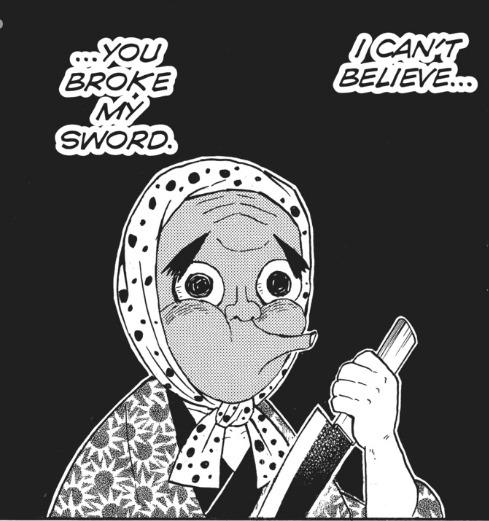
KINOSHITA, Naoyuki. 2001 - From weapon to work of art: “sword hunts” in modern Japan. Senri Ethonological Studies, 54, 119-136; <http://doi.org/10.15021/00002838>;
CLEMENTS, Jonathan. 2017 - A Brief History of Japan: Samurai, Shogun and Zen. The extraordinary story of the land of the rising sun. Chelsea: Tuttle Publishing. Ebook;
PERRIN, Noel. 1979 - Giving up the Gun: Japan’s Reversion to the sword, 1543-1879. New Hampshire. David R. Godine Publisher.
#demon slayer#history#demon slayer from history to fantasy#demonslayerfromhistorytofantasy#history research#japanese history#demon slayer history#kimetsu no yaiba#katana
2 notes
·
View notes
Text
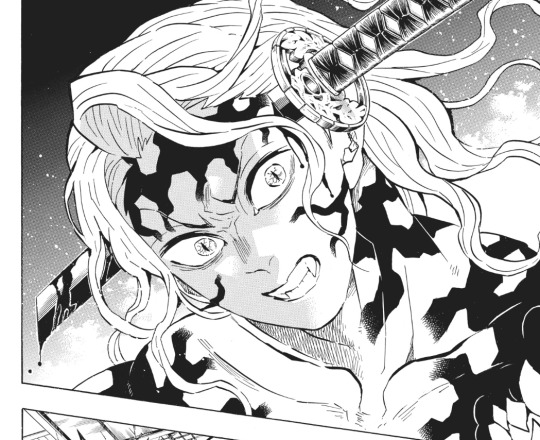
Out of context spoiler for my next blog post~
#demon slayer#demon slayer from history to fantasy#demonslayerfromhistorytofantasy#kimetsu no yaiba#demon slayer manga#manga panel
3 notes
·
View notes
Text

A lil something about the ie [family] on my Ko-fi
#demon slayer#history#demon slayer from history to fantasy#demonslayerfromhistorytofantasy#japanese history#history research#demon slayer history#kimetsu no yaiba#kamado tanjiro#research
1 note
·
View note
Text
Oni in contemporary anime and manga 🧟♀️
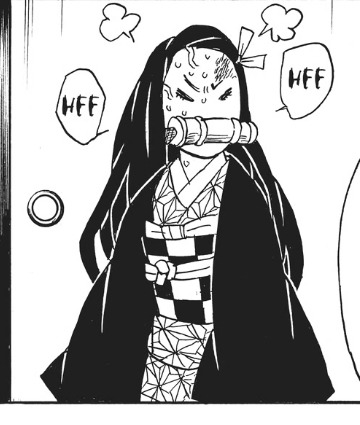
It is funny to think that the Oni concept changed so much during history. Especially in the modern times we start to see big changes in the myths, and in Edo Japan, some towns even start to associate Oni stories to then. It seems kind of weird. Why would a town want to be associate with a being that is a bringer of disease, pollution, barbarian, etc? Well, because just like hero stories would bring people to certain places, the same rule would apply to ghost stories. "The use of legends (as opposed to other genres of storytelling) in this development is noteworthy. As folklorists classify, legends are situated in precise spatial and temporal parameters, in contrast, for instance, to myths, which, invoke abstract scales of space and time" - Carter, 2019; The concept of the Oni changed as much as the Japanese people changed throughout history.
There were a lot of types of Onis, but with the modern times, a new type of Oni was born: the kind and benevolent Oni. The writer Hamada Hirosuke wrote a story called "Naita Akaoni - The Red Oni who Cried", that talks about a Red Oni that wanted to be friends with the humans, and so, his Oni friend, the Blue Oni, attacks the humans so that the Red Oni could be seen saving them. "Hamada's Oni are righteous and pure-hearted: the red Oni is friendly and prepares tea and home-made cakes for the humans, while his counterpart, the Blue Oni, espouses qualities of self-sacrifice by putting the needs of others ahead of his own. The blue Oni is considerate enough to leave the are so as to prevent his friend's cover from being blown. Such conduct among human was increasing rarity at the time the story was written." - Reider, 2003;
After the defeat in the war, people, for that moment, stopped caring about the paranormal and started to think about survival. But it is in these moments that we see the best ideas float. The Japanese pop culture stated to have an extended influence in the midst of the beginning of the social-economic grow of Japan. And thanks to that, right now, anime and manga are the biggest form of contemporary Japanese art.
And if we know a thing or two about anime and manga is that the authors create a lot of magnificent worlds. And some of them are based on history and others on myths. But in contemporary Japan, Oni and all Yokai's alike gained a new life in the world of anime and manga. "Susan Napier writes, "anime, with its enormous breadth of subject material, is ... a useful mirror of contemporary Japanese society, offering an array of insights into the significant issues, dreams, and nightmares of the day" In the various array of subject materials, oni and yokai are important ingredients to help understand the Japanese, as well as the broader human psyche."" - Reider,2010;
Oni were believed to inhabitant the mountains, rivers and forest, so contemporary media had to take these creatures and portrait then in other times and spaces. The important thing is that the Oni is always the "other". This "yokai boom" in contemporary society comes from the fact that, at night the world is illuminated by modern lighting technologies, so this yokai have been robed from their "natural habitat".
Nagai Go was one of the pioneers of Oni related manga. Two examples are his works "Devilman" and " Shuten Doji" where one takes the oni into a more Judeo-Chistian/Divine Comedy idea of the devil, and the other it's on take of the famous Shuten Doji Oni story. In Akira Kurosawa's movie "The weeping demon" we see Humans that were turned to Oni after the bombings and are suffering the aftermath

One of the obvious precursors of our dear Nezuko is obvious Lum from Urusei Yatsura. She is a non-terrestrial Oni. Takahashi Rumiko created the character combining the notion of Oni with the one of aliens. But she does have the so-called typical Oni characteristics: she wears an outfits made out of tiger skin, has two horns, bigger canine teeth that indicate her cannibalistic tendencies, and can use electricity as power. Lum's Oni abilities become more obvious because she behaves just like a normal human, she becomes jealous, angry etc. She is capable of piloting a super advanced spaceship. She and her race are out of the emperor's control.
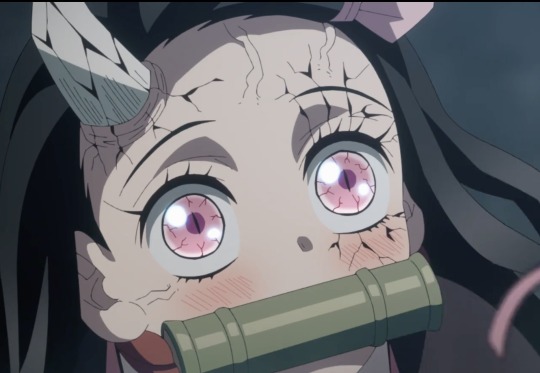
"The Oni has come a long way from being a feared and terrifying creature who threatened the lives of Japanese to one who represents a vital finalcial resource. These days there are even gentle oni, and cute and secy ones. The transformation of Japan's own socieo-economic change [...] Some aspects of the Oni may be emphasized more than others. Furthermore, oni can be used as art objects, or exploited as political weapons. But whatever the means, oni have been always na important part of the japanese psyche, and continue to be so." - Reider, 2013
CARTER, Caleb. 2019 - The demonic countryside: beckoning early modern visitors through oni legend and ritual. Japan Forum, 31:4, 467-486. <https://doi.org/10.1080/09555803.2019.1594336>;
REIDER, Noriko T. 2010 - Japanese Lore: Oni from Ancient time to present. Utah: Utah State University Press. Ebook;
REIDER, Noriko T. 2003 - Transformation of the Oni: From the frightening and symbolical to the cute and sexy. Asian Folklore Studies, Volume 62, 133-157. Ohio: Miami University. <https://www.jstor.org/stable/1179083>;
#demon slayer#demon slayer from history to fantasy#demonslayerfromhistorytofantasy#history#history research#japanese history#demon slayer history#kimetsu no yaiba#urusei yatsura#lum#oni
2 notes
·
View notes
Text

Concepts of hell
0 notes
Text


Is Tsugaru Shinuchi Nezuko's grandfather or this is just me planning yet another essay?
1 note
·
View note